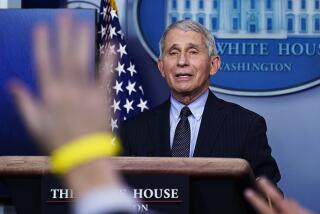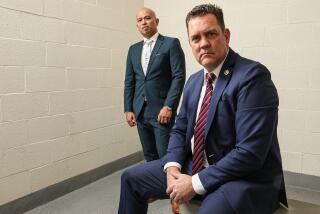A Scientist’s Mystery
- Share via
MEMPHIS — The mystery begins here, 113 feet above the greenish-gray waters of the churning Mississippi.
Two weeks ago, on the Hernando DeSoto Bridge, a Memphis police officer discovered an abandoned rental car checked out to Don C. Wiley, an internationally renowned expert on deadly germs.
The Harvard scientist, a winner of prestigious academic prizes and who was, according to colleagues, on the road to a Nobel prize, had come to town for a meeting and was last seen in the lobby of the Peabody Hotel.
Then he vanished.
Police believe Wiley took his own life, leaping into the Mississippi River. Investigators have so far ruled out robbery, a carjacking or the possibility--unthinkable before Sept. 11--that terrorists kidnapped Wiley to exploit his knowledge of infectious diseases.
“When a car is found on the bridge with the keys in the ignition, our experience has been it’s a suicide,” Walter Crews, director of the Memphis Police Department, said Thursday.
But Wiley’s family and friends don’t accept that, with many believing he was murdered.
The 57-year-old molecular biologist was “at the top of his generation,” said UCLA biochemist David Eisenberg. Wiley was happily married, by all accounts, and an attentive father of four, a runner and an outdoorsman. This winter, the Wiley family was headed to Iceland and the professor was brushing up on his Icelandic, his wife’s native tongue.
“I don’t know what to say,” said his wife, Katrin Valgeirsdottir. “We’re all at such a loss. No one knows what happened.”
The possibility, however remote, that Wiley’s disappearance could be connected to a bioterrorism plot has piqued interest worldwide and increased the pressure on the Memphis Police Department, which has assigned four detectives to the case.
Wiley’s scientific specialty is the molecular structure of infectious diseases and among his work are ground-breaking studies on AIDS, influenza and the deadly Ebola virus.
Despite earlier reports that the FBI was helping with the case, George Bolds, spokesman for the Memphis FBI office, said the agency “was not overseeing, advising, consulting or assisting in any way.”
“There’s never been any evidence that this is connected to terrorism,” Bolds said. “It’s not like anyone has called up and said, ‘We’ve got the doctor and he’s going to make a bioterror weapon.’ ”
Bolds did say, however, that an FBI official in Washington called the Memphis office when he heard about the missing professor.
“I told them it was a missing persons case, nothing else, at least not now,” Bolds said.
Wiley, who teaches biochemistry and biophysics at Harvard, had come to Memphis for an annual meeting of the scientific advisory board of St. Jude Children’s Research Hospital. He has sat on the board for 10 years and every fall would use the meeting as an opportunity to visit his brother and 84-year-old father, who live in the Memphis area.
St. Jude’s Hospital and Harvard each have posted rewards this week for information about Wiley’s disappearance.
On the evening of Nov. 15, Wiley joined other scientists at a banquet in the Peabody Hotel in downtown Memphis, not far from the river.
As the party was winding down, several people saw Wiley walk out of the oak and marble lobby, past the hotel’s signature 8-foot-tall flower arrangement and trickling fountain, toward the door. That was 12:15 a.m.
Three and a half hours later, a truck driver called police. An abandoned white car was blocking traffic on the Hernando DeSoto Bridge, an iron and concrete span over the Mississippi linking Memphis with West Memphis, Ark.
Police arrived to find a Mitsubishi Galant unlocked, keys in the ignition, gas tank full and a hubcap missing. There were no signs of a struggle or foul play. And if Wiley was heading back to his father’s house where he was staying, his car should have never been on the bridge because it’s in the opposite direction.
The circumstances fit the pattern of a suicide, said Memphis Police Lt. Richard True.
“It’s sad,” True said. “But every year we get five or six jumpers who leave their cars on the bridge and sometimes we don’t find a body for months.”
The Mississippi runs swift and deep here, as far down as 50 feet. Police have used helicopters and boats to search the water but so far have found no sign of Wiley.
Investigators are focusing on the three-plus hours between when Wiley was seen leaving the Peabody and when his car was discovered. They have interviewed more than 50 people--friends, family, guests at the Peabody reception, even homeless men on the street.
“We still don’t have any answers,” True said.
Among the close-knit circle of scientists in his rarefied field, there is a widespread sense of confusion about Wiley’s disappearance. E-mails are flying, most of them expressing doubt that Wiley would have killed himself.
“He is so upbeat and successful,” said Eisenberg, director of the UCLA-Department of Energy Laboratory of Structural Biology and Molecular Medicine. “I have seen him on many occasions, and I have never seen a dark side. Invariably, he is very, very solid. He doesn’t have that edge of mania that some very upbeat people have that makes you wonder if they are capable of something like that.”
Eisenberg said he got an e-mail from another scientist who recalled a moment on an Australian beach several years ago when Wiley, a test-tube-thin 6-foot-3, 160 pounds, stood up to some hooligans who were bothering him.
“Maybe there is an independent streak that could have gotten him in trouble when he was accosted,” Eisenberg said.
According to court records and police sources, Wiley was not in debt or being sued and had no history of mental health problems.
He and his wife, also a molecular biologist, have two children, ages 7 and 10, and Wiley has two adult children from a previous marriage.
Wiley has won the $1-million Albert Lasker Medical Research Award, considered by many to be a precursor to the Nobel. His specific area of expertise is X-ray crystallography, and he won the honors for mapping the surfaces of cells in the immune system.
“He is highly, highly original, known for tackling problems that seem beyond the bounds of possibility to others,” Eisenberg said.
And, he added, “Don is invariably friendly, but also sort of critical, like a scientist should be.”
*
Times researcher Edith Stanley in Atlanta contributed to this report.
More to Read
Sign up for Essential California
The most important California stories and recommendations in your inbox every morning.
You may occasionally receive promotional content from the Los Angeles Times.













